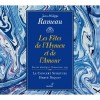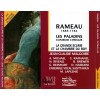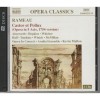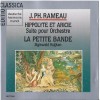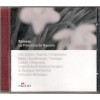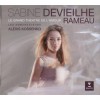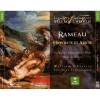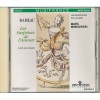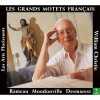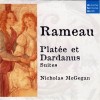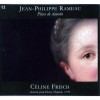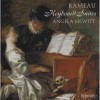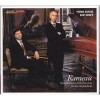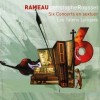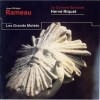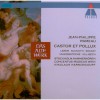Composers
Rameau Jean Philippe was a well known and leading personality among the French composer of his time. No body can forget his musical services that Rameau had done after the death of Couperin in 1733.
Through out his life, Rameau contributed to a variety of dramatic forms, which was based on the Lully tradition. Rameau’s other most successful dramatic work includes; Tragédies lyriques, Comédies lyriques and Comédies-Ballets.
Rameau first successful work Hippolyte et Aricie, was published in 1733, later he works he “Les Paladins” in 1760, for stage presentation, but unfortunately, it remained unperformed. He also wrote several orchestral suites for stage display.
The music was Rameau’s consuming passion and always was so graceful and attractive. It was reflection of Rameau’s entire thinking; Philippe Beaussant calls him “a monomaniac.”
According to Diderot in Le Neveu de Rameau, Rameau’s music was completely contradicts the man's public image of that time. Similarly, according to Piron,
"His heart and soul were in his harpsichord; once he had shut its lid, there was no one home."
No doubt, Jean Philippe made a very significant and lasting contribution to musical theory. He was born on September 25, 1683 in Dijon; two years before the birth of great musician, Handel, Bach and Domenico Scarlatti.
Generally Rameau's music is characterized by the exceptional technical and deep knowledge of a composer, who wanted above all, to be popular and successful as, a great theorist of the art. Nevertheless, Rameau's music was a solely addressed to the intelligence; he himself claimed that he tried to conceal art with art.
As foe as, the early life of Rameau is concerned, the details of his personal life and family life, is vague Rameau's and almost incompletely. Similarly, the detail of Rameau’s early years of career, are obscure and fragmentary, especially, the first forty years, before his travelled to Paris in 1722 or 1723. Even Rameau’s wife did not know any thing his early life clearly.
According to a famous portrait by Carmontelle, Rameau was physically tall and exceptionally thin. He was secretive, solitary, and irritable. He always field proud on his own achievements and often, brusque with those who contradicted him, and quick to anger. He had a "loud voice” man; that is way, his speech was often became very difficult to understand.
Rameau’s father, Jean, was also a very popular musician of that time, and worked as an organist in several churches around Dijon. Rameau mother, Claudine Demartinécourt, was a nice lady and was the daughter of a notary. Claudine Demartinécourt, had got eleven children (five girls and six boys), from Jane, of which Rameau Jean was the seventh.
Later, he got admission at the Jesuit College at Godrans, but Rameau was not a good and devoted student in class. His handwriting was never fluent. He often disrupted classes with his singing attitude, later; he started to complete his opera passion, as he wanted to be a musician and started writing from the age of twelve.
Soon Rameau’s father sent him to Italy, where he stayed for a short while in Milan. Then he got a position of a violinist in travelling companies worked there. Afterword, he became organist in provincial Clermont Cathedrals before moving to Paris for the first time.
Later, he went o Paris and settled there, and published his earliest known collections of harpsichord pieces and important Treatise on Harmony, which was written just before his move to Paris.
Since 1733, Rameau devoted himself for the composition of opera and writing theories on music. Later, he wrote a series of suites like; the Pièces de clavecin en concerts, for harpsichord, flute or violin and second violin or tenor viol, in 1706. This book was written under the influence of his friend Louis Marchand.
In 1709, Rameau moved back to Dijon to take over his father's job as organist in the Milan church. The contract of this post was of six years, but he left this position before the contract date and took up the similar position in Lyon and Clermont.
While staying at Milan, Rameau composed very successful motets for church performance as well as secular cantatas. In 1722, Rameau again returned to Paris for better livelihood, and here he published his most important work of music theory named as, “Traité de l'harmonie” or “Treatise on Harmony”.
There were about sixty of 65 harpsichord pieces, which Rameau written in 1728, and later published in 1741. These keyboard music collections were consisting on the genre pieces and dances by the established tradition of French keyboard music.
In 1724 and 1729 (or 1730), Rameau also published two more collections of very successful harpsichord pieces. He took his first tentative steps for composing stage music, when he composed songs for the Alexis Piron’s popular comic plays, which was especially, written for the Paris Fairs.
Rameau got married with Marie-Louise Mangot in 1726. At that time Marie was 19 years old and also belongs to a musical family from Lyon. She was a good singer and instrumentalist as well. The couple has spent a very happy life and got four children, two boys and two girls. Later Rameau went to Paris, where he served as an organist.
When Rameau was approaching to the age of 50, he decided to embark on the operatic career on which his fame as a composer mainly rests. Thus, he finally inspired operatic thought and try to compose his very prestigious genre entitled as “tragédie en musique” after following the Montéclair's Jephté in 1732.
Afterword, he made the closed relationship with a powerful financier Alexandre Le Riche de La Poupelinière, who soon became his patron until 1753. There were many big personalities of that time like; La Pouplinière's mistress (who later became Rameau’s wife) and Thérèse des Hayes, was Rameau's pupil and a great admirer of his music.
In 1731, Rameau became the conductor of La Pouplinière's private orchestra, and served at this post for 22 years. He was later succeeded by Johann Stamitz and then Gossec.
Meanwhile, Rameau had introduced his new musical style into the lighter genre of the opéra-ballet with the highly successful Les Indes galantes. All these operas of the 1730s are among Rameau's most highly regarded works. However, the composer followed them with six years of silence.
As long as the paradox of this music is concerned, it was new and composed by using the musical techniques that were never known before. A lot of his musical work was written within the framework of old-fashioned forms.
His musical works may be divided into four distinct groups, which are quite different from each other. He also wrote a few cantatas, a few motets for large chorus, and some pieces for solo harpsichord or harpsichord accompanied by other instruments. He devoted his last thirty years of his career for composing stage music.
Most of Rameau's musical compositions were appeared as revolutionary and reactionary to the Lullyistes and philosophies, respectively; which often disturbed the complex harmony of his music.
Later, the incomprehension received from Rameau's contemporaries, compelled him to stop from conducting such daring experiments and repeating them as well.
Rameau's “the second Trio des Parques in Hippolyte et Aricie”, is an evidentiary work of his daring experimentation, but later; he was forced to remove such experimental techniques, as the singers of that time were unable or unwilling to perform.
In his least 26 years, Rameau became a very well known and professional organist due to his musical service for religious institutions. Although, Rameau was very famous at this age, but the body of his sacred music, which he composed was exceptionally small and without any organ works. His few religious compositions are still remarkable today.
From the evidence of Rameau’s musical work, it has been reported that the motets was his favorite field, as it was a simple way of making good and reasonable money for him.
The name of Rameau’s most motets are unknown, there are only four motets that have been attributed to Rameau with certainty, which includes: Deus noster refugium, In convertendo, Quam dilecta, and Laboravi.
The cantata that was a highly successful genre of early 18th century, were Rameau's first contact with dramatic music. In that time there was a great demand of French cantata, but with some restriction that, French cantata, should not be confused with the Italian or the German cantata.
Rameau was very successful in this art. There are only six surviving cantatas of Rameau, but the names of these librettists are unknown. Rameau was also very adept in the art of composing Instrumental music.
Although François Couperin was a big composer for instrumental music in that time but Rameau was also one of the two masters of the French school of harpsichord music in the 18th century. In short, these both composers made a decisive break with the style of the first generation of harpsichordists.
Rameau and Couperin have very different styles and Rameau cannot be considered the follower of the older composer. However, Rameau has very distinguishable style then Couperin, and Rameau style cannot be considered the follower of the older composer.
Today, there is only three Rameau's instrumental music collections appeared, that were written in 1706, 1724 and 1726 or 1727, respectively. Later, Rameau only composed a single piece for the harpsichord that was entitled as: "La Dauphine" and was written in 1747. Rameau's other work for instrumental music which is entitled as, "Les petits marteaux," has been doubtfully attributed to him.
From 1740 to 1744, when it was the period of Rameau's semiretirement, he wrote the Pièces de clavecin en concert (1741), by beautifully employing the successful formula of Mondonville.
In 1733, Rameau dedicated himself towards composing opera on the strictly musical level. In 18th-century French Baroque opera was richer and more varied than contemporary Italian opera, especially in the place given to choruses and dances along with musical continuity, that arises from the mutual relationships of arias and the recitatives.
There was also another essential difference in between Italian opera and French opera.In Italian opera there was also a starring role to female sopranos and castrati, while in French opera there was no use of later tradition
The Italian opera of Rameau's day like; opera seria, opera buffa, was basically divided into two sections, that were, the musical sections and spoken sections, that is way, these opera was quite popular and prominent in that days.
There are five essential components which can be discerned in Rameau's operatic scores, these includes; Pieces of "pure" music, Dance music, the danced interludes, Choruses and Arias.
Rameau's danced interludes were obligatory even in tragédie en musique, and often allowed Rameau to give free rein to his inimitable sense of rhythm, melody, and choreography.
From 1733 to 1739), which was the period of Rameau's first part of operatic career, he wrote his great masterpieces destined for the Académie royale de musique, which includes: three tragédies en musique and two opéra-ballets that still form the core of Rameau's repertoire.
No doubt, Rameau was the greatest ballet composer of all times. Rameau composed two types of ballet. One type of ballet was created to show his perfect artistic permeation by folk-dance,, while the other type of ballet creation was concerned with stage and named as “stage balled”. This kind of ballet was created for live contact of all practical requirements of stage.
After 1744, Rameau became the official court musician, and he composed several successful pieces intended to entertain. In the composition of these pieces Rameau displayed plenty of dance music, which generally, based on sensuality and an idealized pastoral atmosphere.
The year 1745 was a watershed in Rameau's career. He received several commissions from the court for works to celebrate the French victory at the Battle of Fontenoy and the marriage of the Dauphin to a Spanish princess.
Rameau also produced comic opera, most of his important comic opera like; Platée, the opéra-ballet Le temple de la gloire and the comédie-ballet La Princesse de Navarre; were composed with collaborations with Voltaire. Due to these operas Rameau was granted the title "Compositeur du Cabinet du Roi" and later was given a substantial pension.
The year of 1745 was the beginning of some bitter enmity between Rameau and Jean-Jacques Rousseau. Although, Rousseau was also a best known thinker and an ambitions composer of that time, but Rameau was unimpressed by this musical tribute.
There was also some big quarrels happened in between Rameau and Jean-Jacques Rousseau, in which Jean always appeared as a major participant. This enmity period and quarrels often interrupted the Rameau's work and influenced a lot on his career.
Later, Rameau was also accused of being out of date and his music was called as much complicated in comparison with the simplicity and "naturalness".
In the late years of his life, Rameau pursued his activities as a theorist and composer until his death. He lived with his wife and two of his children in his large suite of rooms in Rue des Bons-Enfants. He was often lost in thought, and in order to found solitary, he moved to the nearby gardens of the Palais-Royal or the Tuileries.
At Palais-Royal, he often met with the young writer Chabanon, who was very impressed by him and noted some of Rameau's disillusioned confidential remarks like;
"Day by day, I'm acquiring more good taste, but I no longer have any genius"
Similarly,
"The imagination is worn out in my old head; it's not wise at this age wanting to practice arts that are nothing but imagination."
In 1740s and early 1750s, Rameau began to compose prolifically, but soon his rate of productivity dropped off, which was probably due to old age and ill health, but he was still able to write another comic opera, Les Paladins, and completed it in 1760.
Jean-Philippe Rameau died on September 12, 1764 after suffering from a fever. In his last days he became very thin and week. He was buried in the church of St. Eustache, Paris.
In his last years, Rameau returned to a renewed version of his early style in Les Paladins and Les Boréades, respectively.After the death of Rameau, his all musical work had come under the attack of France theorists, as they were in the favored of music composition in Italian models.
However, foreign composers favored the Rameau’s musical compositions as compared to the Italian tradition. They increasingly looked towards Rameau as a way of reforming their own leading operatic genre, opera seria.
Tommaso Traetta produced two operas setting translations of Rameau libretti that show the French composer has also influenced on Italian composers too, that is quite evident from, the Ippolito ed Aricia (1759) and I Tintaridi (1760).
Gluck also advocated the many of the operatic reforms of Rameau, and mentioned them in the preface of his Alceste. No doubt, Gluck's popularity was also increased due to Rameau work, Gluck he was influenced by his work and followed Rameau’s tradition after the French Revolution.
Rameau had used accompanied recitatives, and the overtures in his later operas, but unfortunately, by the end of the 18th century, all of his operas had vanished from the repertoire. Similarly, for most of the 19th century, Rameau's music remained unplayed, and was mostly known by only reputation.
Until the late 20th century, there was not any serious effort was made to revive Rameau’s musical works, but later, over half of Rameau's operas have been recorded like; John Eliot Gardiner, William Christie, and Marc Minkowski.
Recently Added
Biography
Rameau Jean Philippe was a well known and leading personality among the French composer of his time. No body can forget his musical services that Rameau had done after the death of Couperin in 1733.
Through out his life, Rameau contributed to a variety of dramatic forms, which was based on the Lully tradition. Rameau’s other most successful dramatic work includes; Tragédies lyriques, Comédies lyriques and Comédies-Ballets.
Rameau first successful work Hippolyte et Aricie, was published in 1733, later he works he “Les Paladins” in 1760, for stage presentation, but unfortunately, it remained unperformed. He also wrote several orchestral suites for stage display.
The music was Rameau’s consuming passion and always was so graceful and attractive. It was reflection of Rameau’s entire thinking; Philippe Beaussant calls him “a monomaniac.”
According to Diderot in Le Neveu de Rameau, Rameau’s music was completely contradicts the man's public image of that time. Similarly, according to Piron,
"His heart and soul were in his harpsichord; once he had shut its lid, there was no one home."
No doubt, Jean Philippe made a very significant and lasting contribution to musical theory. He was born on September 25, 1683 in Dijon; two years before the birth of great musician, Handel, Bach and Domenico Scarlatti.
Generally Rameau's music is characterized by the exceptional technical and deep knowledge of a composer, who wanted above all, to be popular and successful as, a great theorist of the art. Nevertheless, Rameau's music was a solely addressed to the intelligence; he himself claimed that he tried to conceal art with art.
As foe as, the early life of Rameau is concerned, the details of his personal life and family life, is vague Rameau's and almost incompletely. Similarly, the detail of Rameau’s early years of career, are obscure and fragmentary, especially, the first forty years, before his travelled to Paris in 1722 or 1723. Even Rameau’s wife did not know any thing his early life clearly.
According to a famous portrait by Carmontelle, Rameau was physically tall and exceptionally thin. He was secretive, solitary, and irritable. He always field proud on his own achievements and often, brusque with those who contradicted him, and quick to anger. He had a "loud voice” man; that is way, his speech was often became very difficult to understand.
Rameau’s father, Jean, was also a very popular musician of that time, and worked as an organist in several churches around Dijon. Rameau mother, Claudine Demartinécourt, was a nice lady and was the daughter of a notary. Claudine Demartinécourt, had got eleven children (five girls and six boys), from Jane, of which Rameau Jean was the seventh.
Later, he got admission at the Jesuit College at Godrans, but Rameau was not a good and devoted student in class. His handwriting was never fluent. He often disrupted classes with his singing attitude, later; he started to complete his opera passion, as he wanted to be a musician and started writing from the age of twelve.
Soon Rameau’s father sent him to Italy, where he stayed for a short while in Milan. Then he got a position of a violinist in travelling companies worked there. Afterword, he became organist in provincial Clermont Cathedrals before moving to Paris for the first time.
Later, he went o Paris and settled there, and published his earliest known collections of harpsichord pieces and important Treatise on Harmony, which was written just before his move to Paris.
Since 1733, Rameau devoted himself for the composition of opera and writing theories on music. Later, he wrote a series of suites like; the Pièces de clavecin en concerts, for harpsichord, flute or violin and second violin or tenor viol, in 1706. This book was written under the influence of his friend Louis Marchand.
In 1709, Rameau moved back to Dijon to take over his father's job as organist in the Milan church. The contract of this post was of six years, but he left this position before the contract date and took up the similar position in Lyon and Clermont.
While staying at Milan, Rameau composed very successful motets for church performance as well as secular cantatas. In 1722, Rameau again returned to Paris for better livelihood, and here he published his most important work of music theory named as, “Traité de l'harmonie” or “Treatise on Harmony”.
There were about sixty of 65 harpsichord pieces, which Rameau written in 1728, and later published in 1741. These keyboard music collections were consisting on the genre pieces and dances by the established tradition of French keyboard music.
In 1724 and 1729 (or 1730), Rameau also published two more collections of very successful harpsichord pieces. He took his first tentative steps for composing stage music, when he composed songs for the Alexis Piron’s popular comic plays, which was especially, written for the Paris Fairs.
Rameau got married with Marie-Louise Mangot in 1726. At that time Marie was 19 years old and also belongs to a musical family from Lyon. She was a good singer and instrumentalist as well. The couple has spent a very happy life and got four children, two boys and two girls. Later Rameau went to Paris, where he served as an organist.
When Rameau was approaching to the age of 50, he decided to embark on the operatic career on which his fame as a composer mainly rests. Thus, he finally inspired operatic thought and try to compose his very prestigious genre entitled as “tragédie en musique” after following the Montéclair's Jephté in 1732.
Afterword, he made the closed relationship with a powerful financier Alexandre Le Riche de La Poupelinière, who soon became his patron until 1753. There were many big personalities of that time like; La Pouplinière's mistress (who later became Rameau’s wife) and Thérèse des Hayes, was Rameau's pupil and a great admirer of his music.
In 1731, Rameau became the conductor of La Pouplinière's private orchestra, and served at this post for 22 years. He was later succeeded by Johann Stamitz and then Gossec.
Meanwhile, Rameau had introduced his new musical style into the lighter genre of the opéra-ballet with the highly successful Les Indes galantes. All these operas of the 1730s are among Rameau's most highly regarded works. However, the composer followed them with six years of silence.
As long as the paradox of this music is concerned, it was new and composed by using the musical techniques that were never known before. A lot of his musical work was written within the framework of old-fashioned forms.
His musical works may be divided into four distinct groups, which are quite different from each other. He also wrote a few cantatas, a few motets for large chorus, and some pieces for solo harpsichord or harpsichord accompanied by other instruments. He devoted his last thirty years of his career for composing stage music.
Most of Rameau's musical compositions were appeared as revolutionary and reactionary to the Lullyistes and philosophies, respectively; which often disturbed the complex harmony of his music.
Later, the incomprehension received from Rameau's contemporaries, compelled him to stop from conducting such daring experiments and repeating them as well.
Rameau's “the second Trio des Parques in Hippolyte et Aricie”, is an evidentiary work of his daring experimentation, but later; he was forced to remove such experimental techniques, as the singers of that time were unable or unwilling to perform.
In his least 26 years, Rameau became a very well known and professional organist due to his musical service for religious institutions. Although, Rameau was very famous at this age, but the body of his sacred music, which he composed was exceptionally small and without any organ works. His few religious compositions are still remarkable today.
From the evidence of Rameau’s musical work, it has been reported that the motets was his favorite field, as it was a simple way of making good and reasonable money for him.
The name of Rameau’s most motets are unknown, there are only four motets that have been attributed to Rameau with certainty, which includes: Deus noster refugium, In convertendo, Quam dilecta, and Laboravi.
The cantata that was a highly successful genre of early 18th century, were Rameau's first contact with dramatic music. In that time there was a great demand of French cantata, but with some restriction that, French cantata, should not be confused with the Italian or the German cantata.
Rameau was very successful in this art. There are only six surviving cantatas of Rameau, but the names of these librettists are unknown. Rameau was also very adept in the art of composing Instrumental music.
Although François Couperin was a big composer for instrumental music in that time but Rameau was also one of the two masters of the French school of harpsichord music in the 18th century. In short, these both composers made a decisive break with the style of the first generation of harpsichordists.
Rameau and Couperin have very different styles and Rameau cannot be considered the follower of the older composer. However, Rameau has very distinguishable style then Couperin, and Rameau style cannot be considered the follower of the older composer.
Today, there is only three Rameau's instrumental music collections appeared, that were written in 1706, 1724 and 1726 or 1727, respectively. Later, Rameau only composed a single piece for the harpsichord that was entitled as: "La Dauphine" and was written in 1747. Rameau's other work for instrumental music which is entitled as, "Les petits marteaux," has been doubtfully attributed to him.
From 1740 to 1744, when it was the period of Rameau's semiretirement, he wrote the Pièces de clavecin en concert (1741), by beautifully employing the successful formula of Mondonville.
In 1733, Rameau dedicated himself towards composing opera on the strictly musical level. In 18th-century French Baroque opera was richer and more varied than contemporary Italian opera, especially in the place given to choruses and dances along with musical continuity, that arises from the mutual relationships of arias and the recitatives.
There was also another essential difference in between Italian opera and French opera.In Italian opera there was also a starring role to female sopranos and castrati, while in French opera there was no use of later tradition
The Italian opera of Rameau's day like; opera seria, opera buffa, was basically divided into two sections, that were, the musical sections and spoken sections, that is way, these opera was quite popular and prominent in that days.
There are five essential components which can be discerned in Rameau's operatic scores, these includes; Pieces of "pure" music, Dance music, the danced interludes, Choruses and Arias.
Rameau's danced interludes were obligatory even in tragédie en musique, and often allowed Rameau to give free rein to his inimitable sense of rhythm, melody, and choreography.
From 1733 to 1739), which was the period of Rameau's first part of operatic career, he wrote his great masterpieces destined for the Académie royale de musique, which includes: three tragédies en musique and two opéra-ballets that still form the core of Rameau's repertoire.
No doubt, Rameau was the greatest ballet composer of all times. Rameau composed two types of ballet. One type of ballet was created to show his perfect artistic permeation by folk-dance,, while the other type of ballet creation was concerned with stage and named as “stage balled”. This kind of ballet was created for live contact of all practical requirements of stage.
After 1744, Rameau became the official court musician, and he composed several successful pieces intended to entertain. In the composition of these pieces Rameau displayed plenty of dance music, which generally, based on sensuality and an idealized pastoral atmosphere.
The year 1745 was a watershed in Rameau's career. He received several commissions from the court for works to celebrate the French victory at the Battle of Fontenoy and the marriage of the Dauphin to a Spanish princess.
Rameau also produced comic opera, most of his important comic opera like; Platée, the opéra-ballet Le temple de la gloire and the comédie-ballet La Princesse de Navarre; were composed with collaborations with Voltaire. Due to these operas Rameau was granted the title "Compositeur du Cabinet du Roi" and later was given a substantial pension.
The year of 1745 was the beginning of some bitter enmity between Rameau and Jean-Jacques Rousseau. Although, Rousseau was also a best known thinker and an ambitions composer of that time, but Rameau was unimpressed by this musical tribute.
There was also some big quarrels happened in between Rameau and Jean-Jacques Rousseau, in which Jean always appeared as a major participant. This enmity period and quarrels often interrupted the Rameau's work and influenced a lot on his career.
Later, Rameau was also accused of being out of date and his music was called as much complicated in comparison with the simplicity and "naturalness".
In the late years of his life, Rameau pursued his activities as a theorist and composer until his death. He lived with his wife and two of his children in his large suite of rooms in Rue des Bons-Enfants. He was often lost in thought, and in order to found solitary, he moved to the nearby gardens of the Palais-Royal or the Tuileries.
At Palais-Royal, he often met with the young writer Chabanon, who was very impressed by him and noted some of Rameau's disillusioned confidential remarks like;
"Day by day, I'm acquiring more good taste, but I no longer have any genius"
Similarly,
"The imagination is worn out in my old head; it's not wise at this age wanting to practice arts that are nothing but imagination."
In 1740s and early 1750s, Rameau began to compose prolifically, but soon his rate of productivity dropped off, which was probably due to old age and ill health, but he was still able to write another comic opera, Les Paladins, and completed it in 1760.
Jean-Philippe Rameau died on September 12, 1764 after suffering from a fever. In his last days he became very thin and week. He was buried in the church of St. Eustache, Paris.
In his last years, Rameau returned to a renewed version of his early style in Les Paladins and Les Boréades, respectively.After the death of Rameau, his all musical work had come under the attack of France theorists, as they were in the favored of music composition in Italian models.
However, foreign composers favored the Rameau’s musical compositions as compared to the Italian tradition. They increasingly looked towards Rameau as a way of reforming their own leading operatic genre, opera seria.
Tommaso Traetta produced two operas setting translations of Rameau libretti that show the French composer has also influenced on Italian composers too, that is quite evident from, the Ippolito ed Aricia (1759) and I Tintaridi (1760).
Gluck also advocated the many of the operatic reforms of Rameau, and mentioned them in the preface of his Alceste. No doubt, Gluck's popularity was also increased due to Rameau work, Gluck he was influenced by his work and followed Rameau’s tradition after the French Revolution.
Rameau had used accompanied recitatives, and the overtures in his later operas, but unfortunately, by the end of the 18th century, all of his operas had vanished from the repertoire. Similarly, for most of the 19th century, Rameau's music remained unplayed, and was mostly known by only reputation.
Until the late 20th century, there was not any serious effort was made to revive Rameau’s musical works, but later, over half of Rameau's operas have been recorded like; John Eliot Gardiner, William Christie, and Marc Minkowski.



















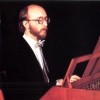











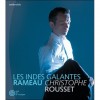






![Janet Baker: ''The Philips & Decca Recordings, 1961 - 1979'' [CD 4 of 5]](http://static.classicalm.com/repository/disk-cover/small/3011-img1372068024246345.jpg)

![Otto Klemperer. Bach: Four Orchestral Suites. Handel, Rameau, Gluck, Cherubin [CD 2 of 2]](http://static.classicalm.com/repository/disk-cover/small/2929-img1362079376388009.jpg)






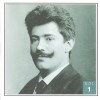





















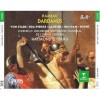













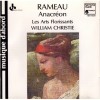








![Rameau - Castor and Pollux - Walker [Live]](http://static.classicalm.com/repository/composition-cover/small/35939-img1566032927880443.jpg)






